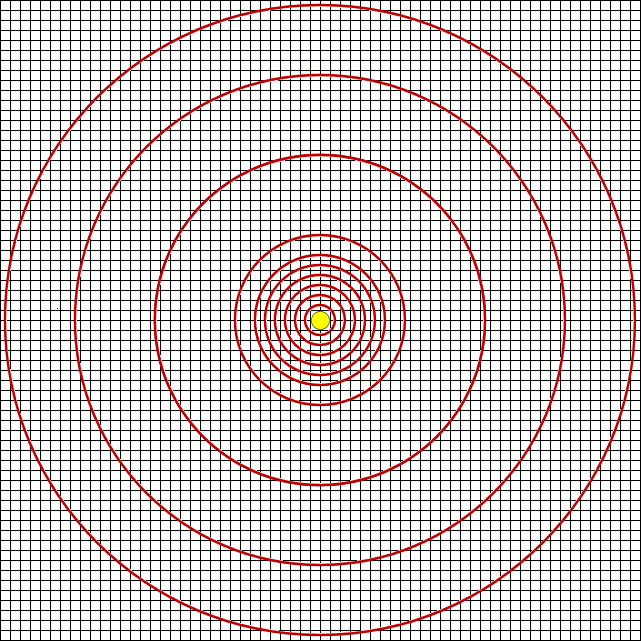BDS Software
Stellar System Thoughts - Page 2
We'll calculate movement and position for all planets based on the orbital distances and periods presented in the table on page 1, but we'll actually show the positions in selectively compressed orbital images based on the 641 x 641 pixel image of the system.
In that image, our sun is currently represented by a yellow orb which is 19 pixels in diameter. And the innermost orbit shown has a radius of 15 pixels. This is about the minimum radius for showing an orbit which is distinct from the sun.
The largest practical orbital radius on the 641 x 641 pixel image would be 315 pixels, and the minimum practical spacing between orbits would be about 10 pixels.
Thus, we'll use orbital images as defined in the following table, where:
● PPlanetNum = Orbit Number beginning with closest to Star and ending with furthest from Star.
● PID = Planet Name or ID.
● PDistance = Mean Orbital Distance (Semimajor Axis = Radius of Circular Approximation), AU * 1000 = milli-AU.
● PIRadius = Calculated orbital image radius, pixels
● PIUseRadius = Actual orbital image radius to use, pixels
After pre-setting PIRadiusMercury = 15, and PIRadiusPluto = 315, then the PIRadius of each of the other planets is calculated as:
PIRadiusplanet =
(PDistanceplanet - PDistanceMercury) * (PIRadiusPluto - PIRadiusMercury)
------------------------------------------------------------------------------------- + PIRadiusMercury
PDistancePluto - PDistanceMercury
(PDistanceplanet - 387) * (315 - 15)
= ------------------------------------------ + 15
39264 - 387
300 * PDistanceplanet + 467055
= ------------------------------------------
38877
PPlanetNum PID PDistance PIRadius PIUseRadius 1 Mercury 387 15.00 15 2 Venus 723 17.59 25 3 Earth 1000 19.73 35 4 Mars 1524 23.77 45 5 Flora 2202 29.01 55 6 Vesta 2362 30.24 55 7 Iris 2385 30.42 55 8 Metis 2387 30.43 55 9 Hebe 2426 30.73 55 10 Astraea 2573 31.87 55 11 Juno 2672 32.63 55 12 Ceres 2766 33.36 55 13 Pallas 2772 33.40 55 14 Hygiea 3138 36.23 55 15 Jupiter 5204 52.17 65 16 Saturn 9582 85.95 85 17 Uranus 19229 160.40 165 18 Neptune 30104 244.32 245 19 Pluto 39264 315.00 315
As you can see from the above table, I've chosen to group all the asteroids into a single orbital image - this is essentially unavoidable given how close together their orbits actually are.
Given this PIUseRadius data, the image of the Solar System orbits (without the planets themselves) will appear as follows:

M.D.J. 2018/07/12